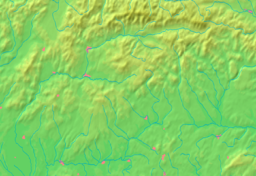Revúca
| Revúca | |
| Town | |
| Country | Slovakia |
|---|---|
| Region | Banská Bystrica |
| District | Revúca |
| Elevation | 318 m (1,043 ft) |
| Coordinates | 48°40′59″N 20°06′48″E / 48.68306°N 20.11333°ECoordinates: 48°40′59″N 20°06′48″E / 48.68306°N 20.11333°E |
| Area | 38.867 km2 (15.007 sq mi) |
| Population | 13,098 (2005-12-31) |
| Density | 337/km2 (873/sq mi) |
| First mentioned | 1357 |
| Mayor | Eva Cireňová |
| Postal code | 05001 |
| Area code | +421-47 |
| Car plate | RA |
| Statistics: MOŠ/MIS | |
| Website: www.revuca.sk | |
Revúca (formerly Veľká Revúca in Slovak; German: Groß-Rauschenbach; Hungarian: Nagyrőce) is a town in Banská Bystrica Region, Slovakia. Revúca is the seat of Revúca District.
The name is of Slovak origin and was initially a name of stream Revúca ("Roaring"). The same names can be found also in Liptov (Liptovské Revúce formerly Revúca and the river Revúca).
The earliest written record of the existence of the town is from 1357. The iron industry was developing for more than 500 years. During the second half of the 19th century, Revúca became a centre of Slovak national revival. The first high school teaching in the Slovak language was founded in Revúca in 1862, but it was closed down by the Hungarian authorities in 1874 (see Magyarization). Both the original building of the high school (with the historical exposition) and the new building are the National Cultural Monuments. During the short period of its existence, the high school attracted many activists, writers, and politicians (Štefan Marko Daxner, Ján Francisci, Július Botto, Samuel Ormis, August Horislav Škultéty, Ivan Branislav Zoch) to the town.
The late Gothic Roman Catholic church of Saint Lawrence (Slovak: Kostol svätého Vavrinca) has a deacon built in the second half of the 15th century and a pre-built tower. Originally, the church had two towers, but the lower one was dismantled after the fire in 1892. The main, pseudo-Gothic altar is decorated by table pictures depicting scenes from the life of Saint Quirin dated to about 1500.
...
Wikipedia




